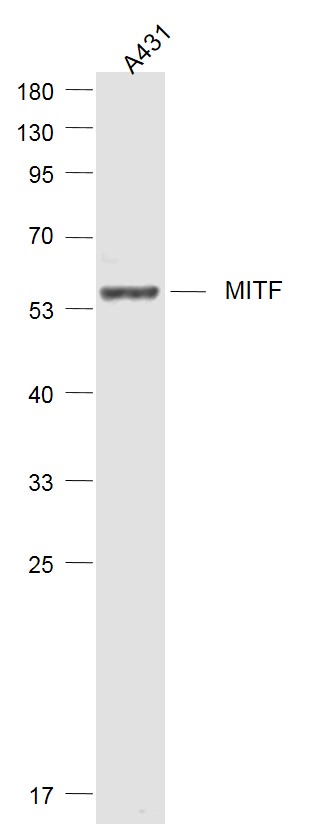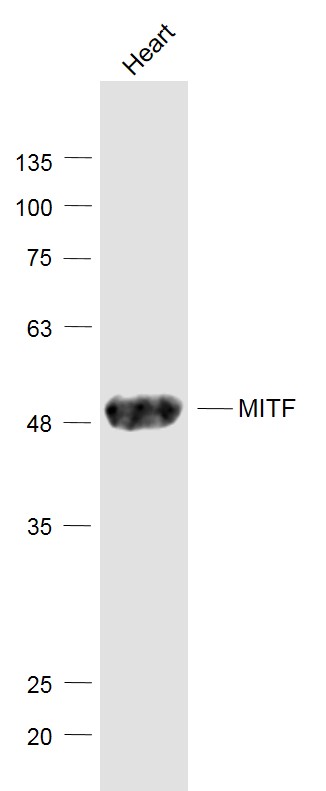
Rabbit Anti-MITF antibody
MITF_HUMAN; Microphthalmia-associated transcription factor; BHLHE32; Class E basic helix-loop-helix protein 32 (bHLHe32); MI; WS2; CMM8; WS2A; COMMAD; MITF-A;
View History [Clear]
Details
Product Name MITF Chinese Name 微小细胞血症相关转录因子抗体 Alias MITF_HUMAN; Microphthalmia-associated transcription factor; BHLHE32; Class E basic helix-loop-helix protein 32 (bHLHe32); MI; WS2; CMM8; WS2A; COMMAD; MITF-A; Research Area Cell biology immunology Chromatin and nuclear signals transcriptional regulatory factor Epigenetics Immunogen Species Rabbit Clonality Polyclonal React Species Human, Mouse, (predicted: Rat, Chicken, Pig, Cow, Rabbit, Sheep, ) Applications WB=1:500-2000
not yet tested in other applications.
optimal dilutions/concentrations should be determined by the end user.Theoretical molecular weight 59kDa Cellular localization The nucleus Form Liquid Concentration 1mg/ml immunogen KLH conjugated synthetic peptide derived from human MITF: 1-100/526 Lsotype IgG Purification affinity purified by Protein A Buffer Solution 0.01M TBS(pH7.4) with 1% BSA, 0.03% Proclin300 and 50% Glycerol. Storage Shipped at 4℃. Store at -20 °C for one year. Avoid repeated freeze/thaw cycles. Attention This product as supplied is intended for research use only, not for use in human, therapeutic or diagnostic applications. PubMed PubMed Product Detail The protein encoded by this gene is a transcription factor that contains both basic helix-loop-helix and leucine zipper structural features. The encoded protein regulates melanocyte development and is responsible for pigment cell-specific transcription of the melanogenesis enzyme genes. Heterozygous mutations in the this gene cause auditory-pigmentary syndromes, such as Waardenburg syndrome type 2 and Tietz syndrome. [provided by RefSeq, Aug 2017]
Function:
Transcription factor for tyrosinase (TYR) and tyrosinase-related protein 1 (TYRP1) that plays a key role in melanocyte development. Binds to a symmetrical DNA sequence (E-boxes) (5'-CACGTG-3') found in the tyrosinase promoter. Plays a critical role in the differentiation of various cell types as neural crest-derived melanocytes, mast cells, osteoclasts and optic cup-derived retinal pigment epithelium.
Subunit:
Efficient DNA binding requires dimerization with another bHLH protein. Binds DNA in the form of homodimer or heterodimer with either TFE3, TFEB or TFEC. Interacts with KARS.
Subcellular Location:
Nucleus.
Tissue Specificity:
Isoform M is exclusively expressed in melanocytes and melanoma cells. Isoform A and isoform H are widely expressed in many cell types including melanocytes and retinal pigment epithelium (RPE). Isoform C is expressed in many cell types including RPE but not in melanocyte-lineage cells.
Post-translational modifications:
Phosphorylation at Ser-405 significantly enhances the ability to bind the tyrosinase promoter. Phosphorylated at Ser-180 and Ser-516 following KIT signaling, trigerring a short live activation: Phosphorylation at Ser-180 and Ser-516 by MAPK and RPS6KA1, respectively, activate the transcription factor activity but also promote ubiquitination and subsequent degradation by the proteasome.
Ubiquitinated following phosphorylation at Ser-180, leading to subsequent degradation by the proteasome. Deubiquitinated by USP13, preventing its degradation.
DISEASE:
Defects in MITF are the cause of Waardenburg syndrome type 2A (WS2A) [MIM:193510]. It is a dominant inherited disorder characterized by sensorineural hearing loss and patches of depigmentation. The features show variable expression and penetrance.
[DISEASE] Defects in MITF are a cause of Waardenburg syndrome type 2 with ocular albinism (WS2-OA) [MIM:103470]. It is an ocular albinism with sensorineural deafness.
[DISEASE] Defects in MITF are the cause of Tietz syndrome (TIETZS) [MIM:103500]. It is an autosomal dominant disorder characterized by generalized hypopigmentation and profound, congenital, bilateral deafness. Penetrance is complete.
[DISEASE] Defects in MITF are a cause of susceptibility to cutaneous malignant melanoma type 8 (CMM8) [MIM:614456]. A malignant neoplasm of melanocytes, arising de novo or from a pre-existing benign nevus, which occurs most often in the skin but also may involve other sites.
Similarity:
Belongs to the MiT/TFE family.
Contains 1 basic helix-loop-helix (bHLH) domain.
SWISS:
O75030
Gene ID:
4286
Database links:
Entrez Gene: 4286 Human
Entrez Gene: 17342 Mouse
SwissProt: O75030 Human
SwissProt: Q08874 Mouse
MITF微小转录因子是一个黑色素细胞的核蛋白,对黑色素细胞的生成和活性起着关键作用,MITF也是控制细胞外信号的一项调节因子。MITF高度表达于原发和转移的恶性黑色素瘤,也可视为高敏感和高特异的黑色素细胞标记。
Product Picture
A431(Human) Cell Lysate at 30 ug
Primary: Anti-MITF (SL21815R) at 1/1000 dilution
Secondary: IRDye800CW Goat Anti-Rabbit IgG at 1/20000 dilution
Predicted band size: 59 kD
Observed band size: 59 kD
References (0)
No References
Bought notes(bought amounts latest0)
No one bought this product
User Comment(Total0User Comment Num)
- No comment




 +86 571 56623320
+86 571 56623320
 +86 18668110335
+86 18668110335

